NVIDIA GeForce 8800 GTS 512 & GeForce 8800 GT 256MB: Playing with Memory and G92
by Anand Lal Shimpi on December 11, 2007 12:00 AM EST- Posted in
- GPUs
8800 GT 512MB vs. 256MB
When AMD released the Radeon HD 3800 series, NVIDIA responded by saying that a cheaper 256MB version of the 8800 GT would be on its way, priced below $200. NVIDIA delivered on part of its promise, we do have a 256MB 8800 GT in hand but it's not a sub-$200 card. The 8800 GT 256 we have is the Alpha Dog Edition XXX from XFX, priced at $229 not including a $10 mail in rebate. That's not too far off the mark but it's still not less than $200.
The XFX card we have runs at a 650MHz core clock but only has a 1.6GHz memory data rate. The reference 512MB card runs at 600MHz core/1.8GHz memory.
Quake Wars starts off showing us a trend we'll see quite often with the 256MB 8800 GT, it performs virtually identically to its 512MB brother until after 1600 x 1200 then there's a sharp drop off:
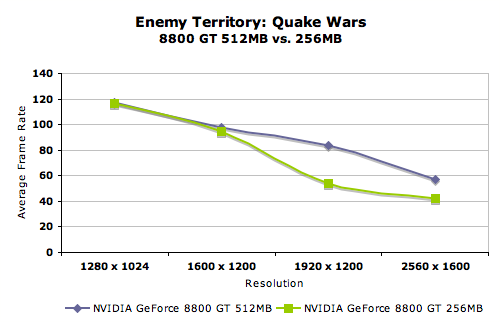
The performance hit isn't as pronounced when you turn on AA, instead you get a 10 - 20% hit across the board:
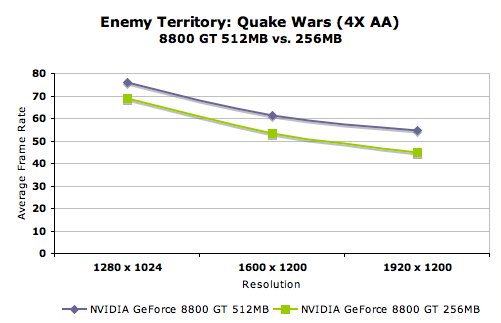
Bioshock shows the same thing, competitive performance up to 1600 x 1200 but at 1920 x 1200 the 512MB card has a 16% advantage, and a 60% advantage at 2560 x 1600. It is worth noting that neither card is really playable at 2560 x 1600 in Bioshock.
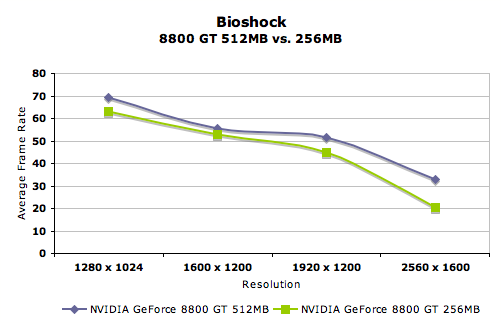
World in Conflict moves the choke point up to 1600 x 1200; the two cards behave similarly at 1280 x 1024, but the 512MB 8800 GT holds on to a 20% minimum advantage at 1600 x 1200 and grows it to 40% at 2560 x 1600.

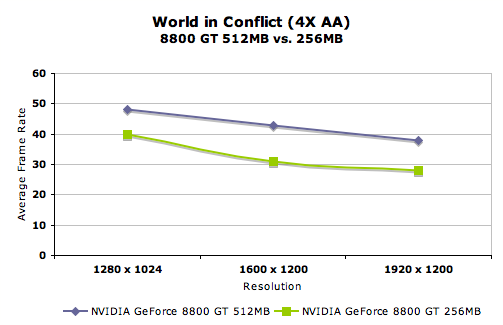
Older titles like Half Life 2 and Oblivion show absolutely no difference between the two cards, showing us that this current wave of games and most likely all those to follow require larger than 256MB frame buffers. While 256MB could cut it in the Half Life 2 and Oblivion days, the same just isn't true any more.
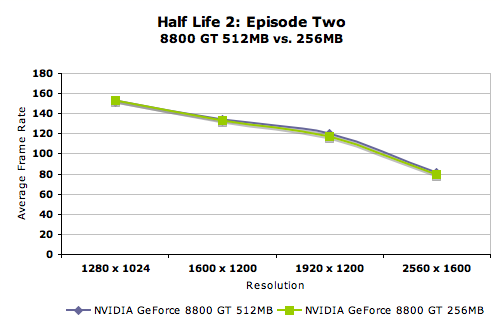
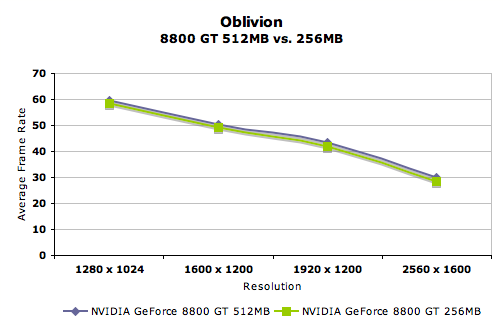
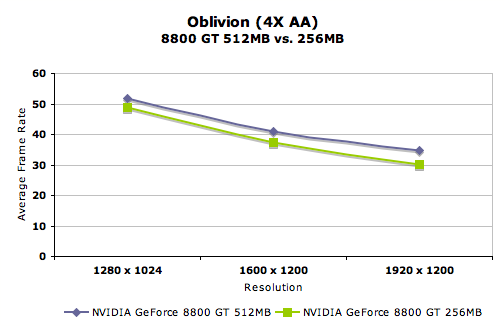
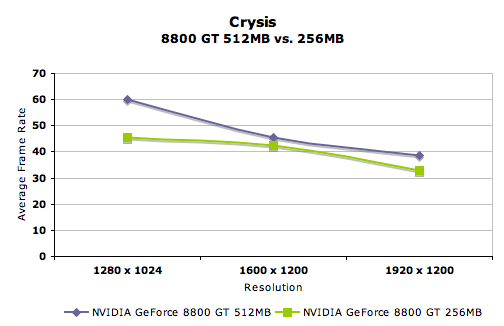

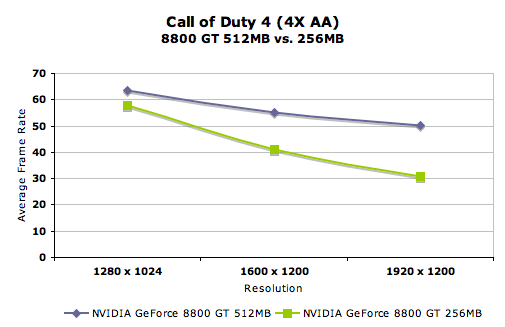
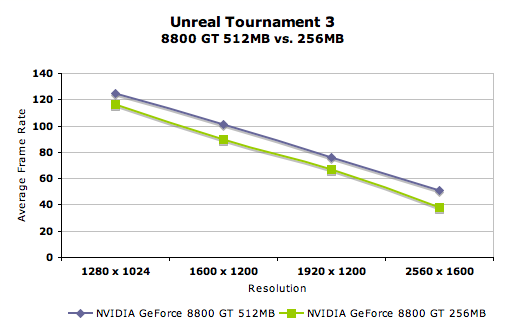
What we have here is an 8800 Ultra that's $50 more for not much more gain, and a 256MB 8800 GT that's at least $70 cheaper for a lot less performance. If you plan on keeping this card for any length of time, it looks like 512MB is the way to go. Frame buffer demands of modern games are only going to increase, and it looks like what we're seeing here today is an indication that the transition to 512MB as a minimum for high end gaming performance is officially underway. The 768MB memory sizes of the 8800 GTX are still not totally required, but 512MB looks like the sweet spot.










56 Comments
View All Comments
Lennie - Tuesday, December 11, 2007 - link
Gotcha!! ATJ/K :b
Test System got DDR2 mentioned as memory but the mobo is P5E3.
Over and out.
Lennie - Tuesday, December 11, 2007 - link
Man tat was quick. Thank ya.Cygnis - Tuesday, December 11, 2007 - link
I've been reading these "benchmarks" for a while now. and the hardware is always a Intel w/ Nvidia chipsets etc.It's a little biased, in my opinion, to run an ATI card in those chipsets.
It would only be fair, and more realisitic to run Both Nvidia cards and ATI cards in Two different Boxes, cross-manufacturer, to get a true idea.
After all, you are trying to be fair in the representation of the data, no?
strikeback03 - Wednesday, December 12, 2007 - link
The chipset is an Intel X38. As this can run Crossfire, I'd imagine it is reasonably friendly to AMD graphics cards.pilotofdoom - Tuesday, December 11, 2007 - link
What happens when the 3850 512MB is compared to the 8800gt 256MB? Right now the 3850 512MB retails around $200, so about $20 more expensive than the 256MB version, but still $15 cheaper than the 8800GT 256MB card, assuming you find the cards in stock.Viditor - Wednesday, December 12, 2007 - link
"Right now the 3850 512MB retails around $200"
Actually, the 3850 is retailing for $169 at NewEgg...
kilkennycat - Tuesday, December 11, 2007 - link
The default fan speed on the 8800GT (512) is 29% and the speed-profile is a joke. The fan speed does not move AT ALL until the GPU reaches ~ 94 degrees C!! This is not long-term-reliability funny at all. Is TSMCs commercial silicon-process rated for military-grade applications ( >70 degrees C )? I don't think so. And the only control the user has on fan-speed without a risky video BIOS sabotage is to use the fixed-fan settings courtesy of nTune. However, these settings are not saved during a system re-boot.So since the physical design of the ventilation on the 8800GTS 512 has changed from that of the 8800GT, have nVidia taken any steps to change from the ridiculous fan-speed profile of the 8800GT (512) ?? Or given the user any ability to manually control the speed profile and SAVE THE SETTINGS?
AnnonymousCoward - Wednesday, December 12, 2007 - link
No kidding! The last time I tried nTune it would also go back after every reboot. To OC I started making EXPERTOOL start on startup and then I close it manually to free the memory, and the OC stays. I don't know if Riva lets you do that.jay401 - Tuesday, December 11, 2007 - link
most owners are using RivaTuner to allow the fan speed to be dynamically adjusted by the temperature or to simply set a higher default, fixed fanspeed.kilkennycat - Tuesday, December 11, 2007 - link
Does the fan-adjust feature of RivaTuner work properly on WinXP with the latest nV drivers 169.09beta and above (req'd for Crysis etc..)?? If so, please specify the version of Rivatuner and point me in the right direction to manipulate the fan settings.